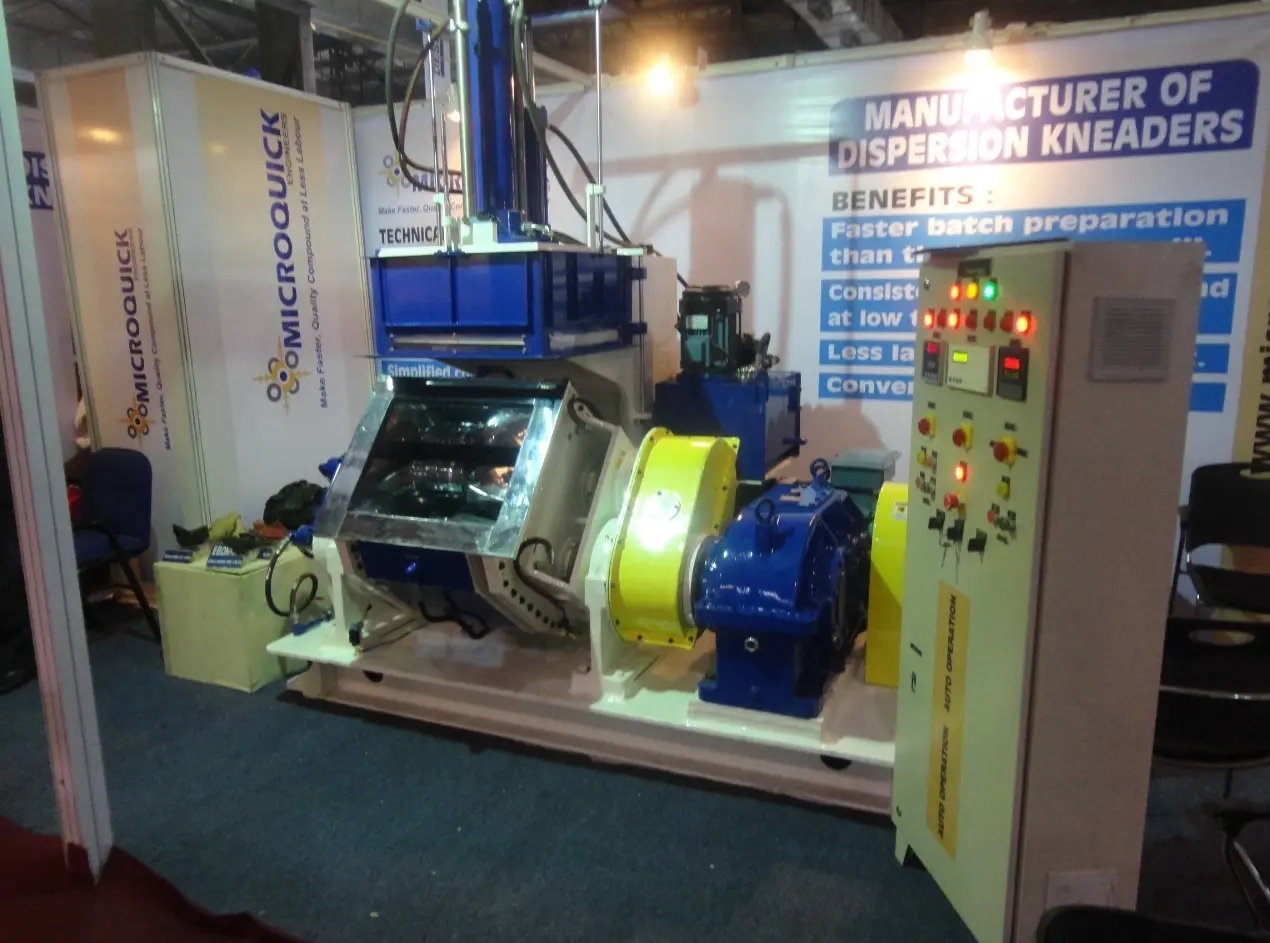Choosing the Perfect Rubber Mixer: 5 Key Tips
Rubber manufacturing professionals and businesses looking to invest in a rubber mixer need to carefully consider several factors to ensure they choose the perfect mixer for their needs. Here are five key tips to help you make an informed decision:
-
Opt for a mixer with automated continuous hydraulic compression. Microquick Engineers’ Hydraulic Dispersion Kneaders offer this feature, ensuring excellent quality compounding by continuously compressing the ingredients. With this technology, you can achieve consistent and high-quality results.
-
Consider batch preparation time. Microquick Engineers’ kneaders have a batch preparation time of 7-12 minutes, allowing for faster production. This can significantly increase efficiency and productivity in your rubber manufacturing process.
-
Ensure excellent dispersion of ingredients. Microquick Engineers’ Hydraulic Dispersion Kneaders are designed to ensure excellent dispersion of ingredients, resulting in uniform and reliable mixing.
-
Look for durability and convenience. Microquick Engineers’ kneaders feature wear resistance in the mixing chamber and anti-breakage properties of the rotors, making them suitable for producing hard batches. This durability ensures a longer lifespan for the mixer and reduces maintenance costs.
-
Prioritize energy efficiency. Microquick Engineers’ kneaders have innovative shaft seals with lubrication passage to prevent ingredient leaks and have low energy consumption. This helps to reduce operational costs and contributes to a more sustainable and environmentally friendly manufacturing process.
By considering these five key tips, rubber manufacturing professionals and businesses can choose the perfect rubber mixer for their needs. Whether you’re looking to improve efficiency, ensure consistent quality, or reduce energy consumption, Microquick Engineers’ Hydraulic Dispersion Kneaders offer a reliable and innovative solution. Visit their website to learn more about the technical features and applications of their kneaders and explore their brochure and exhibition events for further information.
Choosing the Right Rubber Mixer
Choosing the right rubber mixer is crucial for ensuring the quality and efficiency of compounding in various industries like tire manufacturing, automotive, and construction. There are several important factors to consider when making this decision. One of the key factors is the type of rubber mixer available in the market. Different types of mixers, such as open mill mixing, internal mixer (Banbury mixer), continuous mixers, single screw extruders, and twin screw extruders, offer different advantages and are suitable for different applications.
The selection of a rubber mixer also affects the overall performance and quality of the end product. For example, the mixing time and temperature, additive dispersion and homogenization, filler loading and type, and chemical reactions and curing all play a role in determining the properties of the final compound. By choosing the right mixer and optimizing these parameters, manufacturers can achieve consistent and high-quality compounds.
However, the process of rubber mixing comes with its own set of challenges. Inconsistent material quality, poor dispersion of additives and fillers, overheating and premature curing, inadequate mixing time, equipment malfunctions, material contamination, and operator skill and training are some of the common challenges faced during rubber mixing. Overcoming these challenges requires a combination of proper equipment selection, process optimization, and operator training.
In conclusion, choosing the right rubber mixer is essential for achieving high-quality compounds and improving the efficiency of compounding. It is important to consider factors such as the type of mixer, the specific requirements of the application, and the challenges that may arise during the mixing process. By addressing these factors, manufacturers can enhance the performance of their products and meet the demands of various industries.
Choosing the Perfect Rubber Mixer
Choosing the perfect rubber mixer is crucial for achieving high-quality compounding in various industries. By understanding the different types of rubber mixers, you can make an informed decision based on your specific needs.
Types of Rubber Mixers
- Open Mill Mixing: This type of rubber mixer is commonly used for compounding rubber. It involves two rotating rolls that mix and blend the rubber.
- Internal Mixer (Banbury Mixer): The Banbury mixer is another popular type of rubber mixer. It uses intermeshing rotors to mix and blend the rubber.
- Continuous Mixers: Continuous mixers are used for high-volume production. They offer efficient and continuous mixing of rubber.
- Single Screw Extruder: Single screw extruders are used for rubber compounding and shaping. They provide uniform mixing and extrusion of rubber.
- Twin Screw Extruder: Twin screw extruders are similar to single screw extruders but with two screws. They offer enhanced mixing capabilities.
Key Factors to Consider
- Mixing Capacity and Batch Size: Determine the mixing capacity and batch size required for your production needs.
- Mixing Efficiency and Homogeneity: Look for a rubber mixer that ensures efficient mixing and uniform dispersion of additives.
- Temperature Control: Consider the temperature control features of the rubber mixer to prevent overheating and premature curing.
- Safety Features: Choose a rubber mixer with adequate safety features to protect operators and prevent accidents.
- Maintenance and Longevity: Consider the maintenance requirements and expected lifespan of the rubber mixer.
- Return on Investment: Evaluate the cost-effectiveness and potential return on investment of the rubber mixer.
Applications of Rubber Mixing
The selection of the right rubber mixer has a significant impact on different applications, including:
- Tire manufacturing
- Automotive industry
- Industrial seals and gaskets
- Conveyor belts and power transmission belts
- Footwear and shoe soles
- Construction and building materials
- Medical devices and equipment
- Consumer goods
- Electronics and electrical insulation
- Sports and recreation equipment
By overcoming challenges such as inconsistent material quality, poor dispersion of additives and fillers, overheating and premature curing, inadequate mixing time, equipment malfunctions, material contamination, operator skill and training, poor quality control and testing, and environmental factors, you can ensure efficient rubber mixing.
Microquick Engineers’ Hydraulic Dispersion Kneaders
When choosing a rubber mixer, consider Microquick Engineers’ Hydraulic Dispersion Kneaders. These kneaders offer:
- Automated continuous hydraulic compression
- Excellent dispersion of ingredients
- Wear resistance and anti-breakage properties
- Innovative shaft seals with low energy consumption
To learn more about Microquick Engineers’ products, you can check out their brochure, explore exhibition events, dive into technical features, or discover their Hydraulic Dispersion Kneader and Vacuum Type Automatic Compression Rubber Moulding Machines.
Remember, selecting the right rubber mixer is the key to improved compounding quality and efficiency.
For more information, visit Microquick Engineers’ website: https://microquick.us


